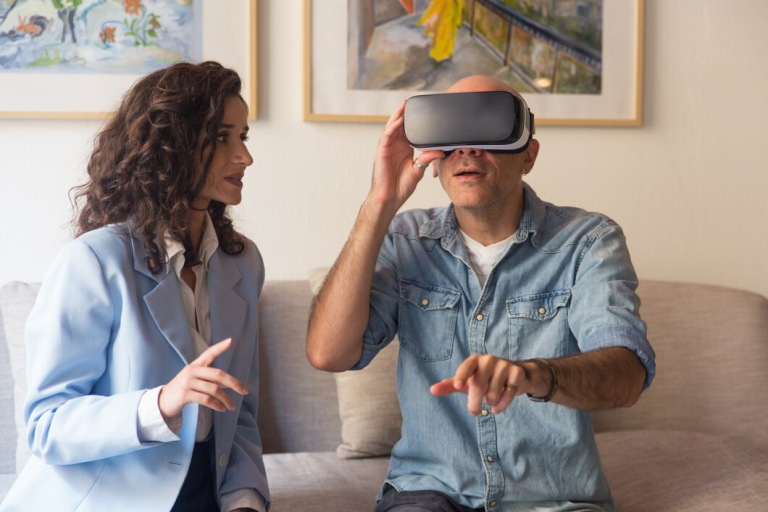As technology transforms the way we design and build, Virtual Reality (VR) and Augmented Reality (AR) are becoming indispensable tools in architecture. These immersive technologies enable architects to visualize, communicate, and execute projects with precision and creativity, enhancing the experience for clients and professionals alike. While VR and AR share similarities, their applications in architecture are distinct and complementary.
Here’s an in-depth exploration of how VR and AR are shaping the future of architecture and when to use each technology to its fullest potential.
What is Virtual Reality (VR) in Architecture?
VR creates a fully immersive digital environment that allows users to step into a computer-generated 3D model. By using VR headsets and controllers, architects and clients can navigate and interact with virtual spaces, experiencing designs in lifelike detail.
Key Applications of VR in Architecture:
- Immersive Design Visualization:
Architects can create detailed virtual models of buildings, offering clients a realistic sense of scale, layout, and materials. VR enables users to explore a project from different angles and perspectives, making it easier to identify design strengths and weaknesses.Stat: Projects incorporating VR report a 40% reduction in design errors, saving time and money. - Virtual Walkthroughs:
Unlike traditional renderings, VR allows clients to “walk” through a building before construction, fostering a deeper understanding of the space. - Construction Training and Safety Simulations:
VR provides a safe environment for training construction teams on complex processes, improving efficiency and reducing on-site accidents.
Example:
A commercial development project in California used VR walkthroughs to finalize designs, resulting in a 20% reduction in design revisions.
What is Augmented Reality (AR) in Architecture?
AR overlays digital information onto the real world, allowing users to see and interact with virtual elements superimposed on physical environments. With AR, architects can blend digital designs with existing structures, offering a dynamic way to visualize projects.
Key Applications of AR in Architecture:
- On-Site Visualization:
AR enables architects to overlay 3D models onto construction sites using smartphones, tablets, or AR glasses. This helps visualize the project in its intended environment and identify spatial conflicts early.Stat: AR applications reduce on-site errors by 25%, leading to smoother construction workflows. - Client Presentations in Context:
Clients can view proposed designs in their intended locations, such as seeing a future office layout within its physical site. - Real-Time Design Modifications:
During meetings, architects can make adjustments to designs, and AR will display updates immediately. This interactivity streamlines collaboration and decision-making.
Example:
An architecture firm in New York used AR to superimpose a new facade design onto an existing structure during client presentations, enhancing decision-making speed by 30%.
Key Differences Between VR and AR
| Feature | Virtual Reality (VR) | Augmented Reality (AR) |
|---|---|---|
| Immersion | Fully immersive, isolates the user from the real world. | Enhances the real world by overlaying digital elements. |
| Equipment | Requires VR headsets (e.g., Oculus, HTC Vive). | Accessible via smartphones, tablets, or AR glasses. |
| Applications | Ideal for walkthroughs, simulations, and immersive designs. | Best for on-site visualization and real-time collaboration. |
When to Use VR vs. AR in Architecture
- Conceptual Design Phase:
Use VR to explore design options, create immersive walkthroughs, and refine layouts. - Client Presentations:
Use AR to showcase how designs will integrate into existing spaces. For instance, overlaying a new interior design onto a current room helps clients visualize changes. - Construction and Implementation:
Combine both technologies—VR for worker training and AR for real-time on-site guidance and troubleshooting.
Combining VR and AR for Maximum Impact
While VR and AR have unique applications, their integration can unlock even greater potential. By combining VR’s immersive capabilities with AR’s real-world context, architects can streamline workflows and enhance communication at every stage of a project.
Example Workflow:
- Use VR for detailed project walkthroughs during design phases.
- Transition to AR for on-site visualization and implementation, ensuring the design aligns perfectly with the physical space.
Stat: Firms that integrate both VR and AR in their workflows see a 35% improvement in project efficiency.
Future Trends in VR and AR for Architecture
The use of VR and AR in architecture is still evolving, with new advancements on the horizon:
- Multi-User Collaboration:
Both VR and AR are moving towards allowing multiple users to interact in shared virtual or augmented spaces. - AI Integration:
AI-powered VR and AR tools will offer real-time design suggestions, enhancing creativity and efficiency. - AR Smart Glasses:
Devices like Microsoft HoloLens are becoming more sophisticated, allowing for precise on-site visualization and interactive design tweaks.
Fact: The global market for VR and AR in architecture is expected to reach $10 billion by 2030, driven by demand for immersive technology in design and construction.
Why VRchitects is the Perfect Partner for VR and AR in Architecture
At VRchitects, we specialize in bringing architectural visions to life with cutting-edge VR and AR tools. Our expertise ensures:
- Immersive VR walkthroughs that enhance design presentations.
- Seamless AR integration for on-site visualization and client collaboration.
- A forward-thinking approach that leverages the latest trends in immersive technology.
Whether you’re designing a commercial building, residential property, or public space, VRchitects can help you revolutionize your architectural process.
Final Thoughts
Virtual Reality and Augmented Reality are not just tools; they are transformative technologies reshaping the architectural industry. By understanding their distinct applications and integrating them strategically, architects can create designs that are immersive, precise, and client-focused.
Ready to transform your architectural projects with VR and AR? Contact VRchitects today to explore the possibilities!






